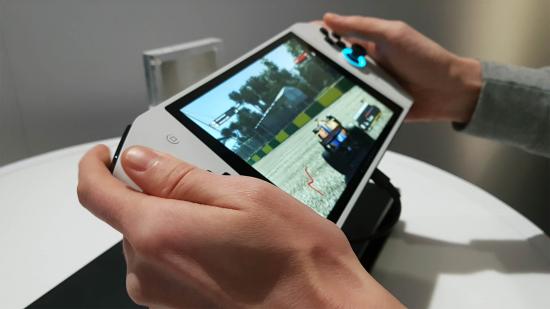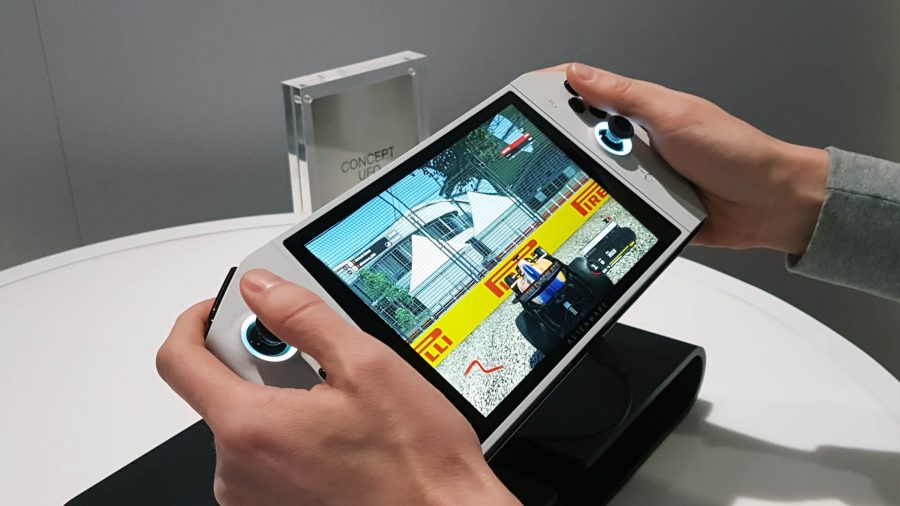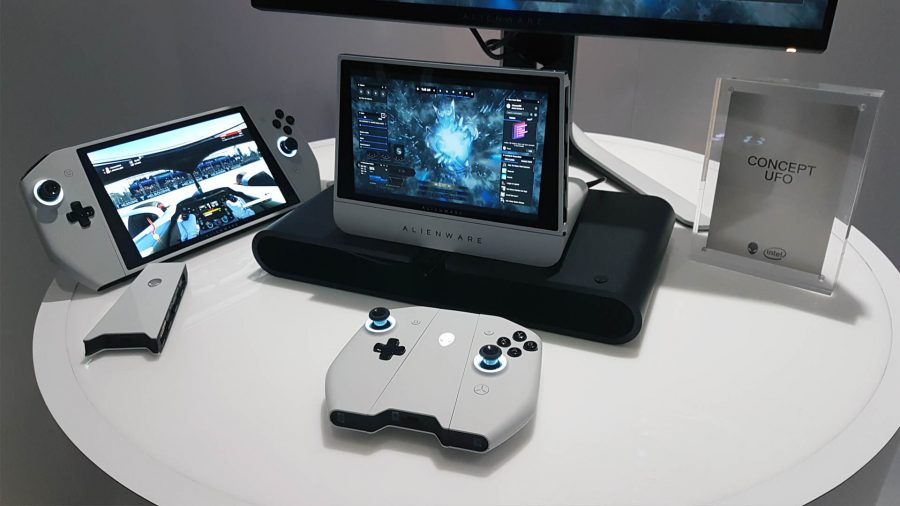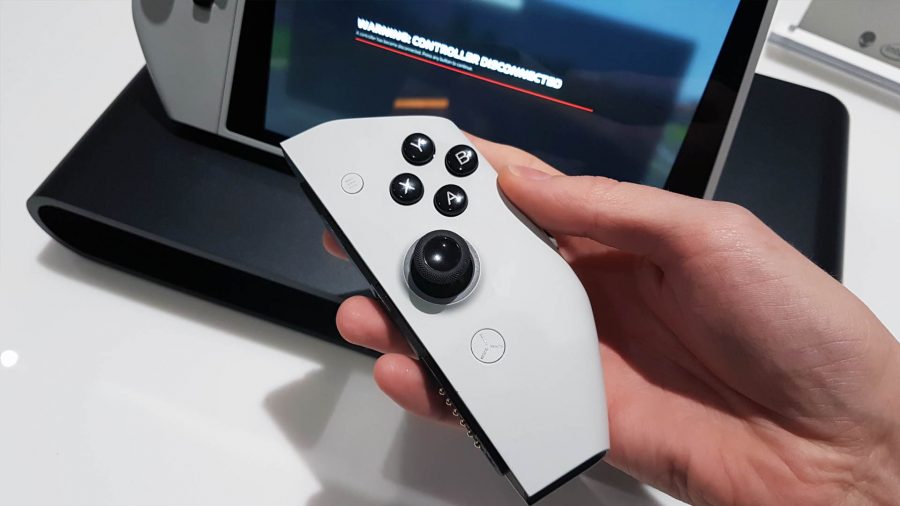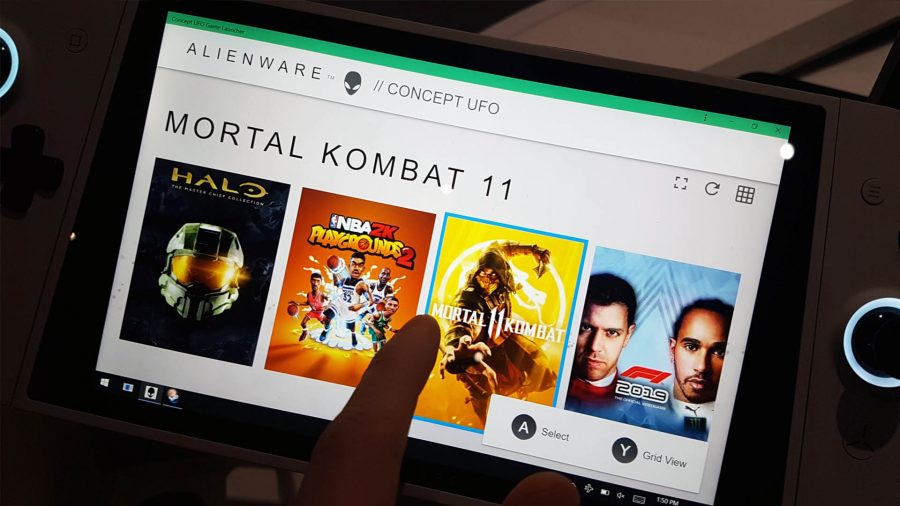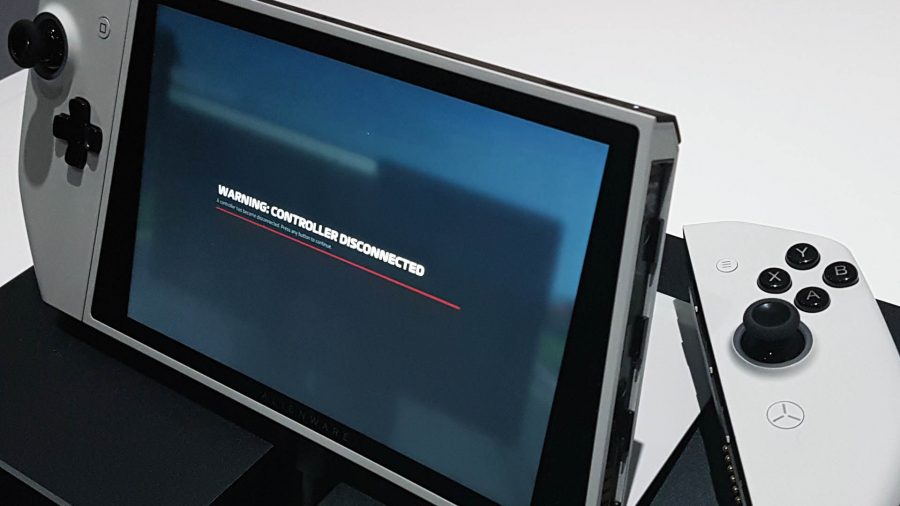I take my Nintendo Switch everywhere. It’s followed me from press event to outdoor vacation to rainy coastal getaways. Access to videogames with such ease, wherever and whenever I want, has changed how I play and what I play – and my backlog of indie games has shrivelled up altogether as a result. So that’s perhaps why when I first caught sight of Alienware’s new Concept UFO handheld I was intrigued, to say the least.
The Concept UFO, Dell and Alienware’s latest gaming venture, bears striking resemblance to the Nintendo Switch. From the Joycon-style removable controllers and central tablet screen, to the system’s dock and rear stand, it’s a device built to be enjoyed in much the same way as Nintendo’s popular console.
Is it truly a carbon-copy? No, not quite. But for a PC gaming systems manufacturer whose remit lies solely in premium pre-builts, the Concept UFO is quite a departure for Alienware nonetheless. We’ve sat down with Matt McGowan, director of product planning and marketing at Dell, to find out a little more about this oddly familiar handheld, why the heck it exists, and have a go for ourselves.
“We’ve been in the desktop and the notebook space for some time and we’ve even tried other kinds of concepts in the past that we brought to market, like the Steam Box,” McGowan explains while gesturing to the size of the Alienware Steam Machine. “All of our internal guys absolutely love it but it just, for whatever reason, didn’t quite stick. So I think that culturally inside of Alienware we’re constantly looking at different use cases and different ways to enable PC gaming in different locations.
“We saw a market for mobile PC gaming that wasn’t being addressed. So the Switch is obviously the closest comparison. But this is much, much more,” McGowan continues.
There’s an Alienware Steam Machine sat of the edge of my desk, I tell McGowan. But I keep its state of disrepair and dismantling a secret at the time – it’s well broken and has been for some time. But it would appear Alienware is a little more cautious to new product categories this time around in order to avoid the pitfalls of the past.
“There are so many new categories, a lot of missteps, and then they kind of fade away to nothing. We think this is a really great category, a really interesting category, in which we don’t want to have any missteps when it comes to production.”
At first glance Concept UFO has all the makings of a volume production unit. For a prototype of a product that may never launch, it is remarkably polished. The textured finish and analogue stick RGB lighting screams shipping product, and that’s a sentiment shared by Dell’s top brass.
“I’ve been with the industry for 20 years and I’ve never seen a fidelity concept as high as that, what we’ve done on this one,” McCowan says. “But that said, we’re definitely looking for feedback because we’re in a bit of uncharted territory. We want to understand what people think, what they should have to pay for this, what needs to be included in the box, what are the issues with it.”
You have to remind yourself that, despite its clean-cut aesthetic, the Concept UFO remains a prototype. Even the units at Dell’s own event were thin on the ground, with roughly three or four in circulation at any given time – we’re told these show floor units number almost all extant devices.
“We really tried to do something that was that looked production so that people could get a sense of what this thing would be.”
But once you’re in possession of the Concept UFO, the sheer mass of this device is pretty striking, too. The system is built around a large 8-inch touchscreen with a resolution of roughly around 1200p (so we’re told). The minimal screen size plays into the UFO’s strengths, and the pixel density is noticeably superb across the little panel. It delivers a crystal-clear image in handheld mode.
But also much like the Nintendo Switch, Alienware’s put together a shapely L-shaped dock capable of mirroring the handheld image onto the big screen. Today that’s designed as a simple 1:1 mirror go-between for the handheld device and connected monitor, but a company representative tells us any would-be production model would almost certainly feature upscaling.
The Concept UFO feels decisively familiar in-hand, yet its weight appears to be more adequately dealt with than its Japanese cousin. With a weight, I would guess, some 1.5x that of the Nintendo Switch, if not more, ergonomics have certainly been a major consideration in any pre-emptive design talks over at Dell.
My one qualm with the Nintendo Switch, and bear in mind I will fight almost anyone that has a bad word to say about it, is the lack of rear grip across the Joycons. I understand the why of the matter, and I have a case to make up for it, but it’s not quite a console cut-out for adult hands. The Concept UFO, however, is a little more considered.
“A lot of work went into the ergonomics and that’s why we’re on our second or third iteration [of Concept UFO],” McGowan says. “The usability, the ergonomics of where the switches are, how it feels, we had to take into account the fact that this is a slightly heavier device. And so you have to get a better grip on it so you don’t drop it. And so you’ll notice the contour on the back side. We wanted to make sure that you could hold it with one handed and slip out. So a lot of considerations went into how that feels.
“It’s much different than the Switch and there are a lot of reasons behind that. One of them is screen sizes, another I think that the user base around PC gaming often has slightly larger hands, so you know we had to dial that in. We don’t want it to be overly large, but we don’t want it to be a really small. So striking that right balance took us a couple of times to do that.”
The Concept UFO is powered by an Intel 10th Gen processor. Dell is reticent to divulge the exact specification, but we’re pretty sure Comet Lake’s UHD graphics won’t cut it even in a micro-machine such as this. Ice Lake and Gen11 graphics it is.
But even Ice Lake might not make it into a final Alienware handheld, if such a product were to materialise.
“Depending on if we bring it to market and when that would happen, we would look for the latest and the best technology,” McGowan says.
| Concept UFO | |
| CPU | Intel 10th Gen (Ice Lake) |
| GPU | Gen11 integrated graphics |
| Storage | Removeable NVMe SSD |
| Screen | 8-inch |
| Resolution | 1200p |
| OS | Windows 10 |
| Store compatibility | Steam, Epic Games Store, Origin, Battle.net, etc. |
McGowan doesn’t say whether Dell is considering next-gen SoCs, such as Intel Tiger Lake, following availability later in the year. He tells us the Concept UFO was first built around 9th Gen Intel SoCs, or Coffee Lake chips – hence a CPU upgrade isn’t entirely out of the question. Tiger Lake would also offer graphical performance above and beyond Ice Lake’s capabilities, thanks to the Intel Xe graphics architecture and EU count.
“We have to strike that balance between performance and acoustics. Your point about ‘technology is only going to get better’ is absolutely right, but it may not be you’re going to get even better performance. It may be that you’re going to get a cooler, quieter system, and maybe longer battery life. We do systems, that’s really where our expertise lies… in striking that right balance. That’s how we get to the z-heights we get to and still maximise performance. And we’re really trying to understand where all of that sits, where’s that right spot.”
The Concept UFO appears thermally sound, which was my initial concern following its announcement. The exhaust, located on the top and facing away from the hands (as per the Switch), was plenty busy during a bout of Rocket League and F1 2019, but it is far from scorching. The intakes on the rear of the device are evidently enough to maintain a steady current of cool air across the top of the Intel chip.
However, despite the din surrounding the Dell event (located in a bar in one of the busiest thoroughfares of CES 2020), the small radial fan within the Concept UFO emits an audible high-pitched whirr. The device has been operational for some time, and may not be entirely representative of the final design, but the more powerful the chip within, the more capable the thermal solution required. Fan noise and thermal performance could be make or break for the Concept UFO.
As for gaming performance, it’s hard to argue with the Concept UFO’s potential. Few, if any, drops in fps were noticeable during a brief play session in F1 2019, and it maintains course even as we test its limits. What’s impossible to say at this time is the graphical fidelity chosen for our demo, as we were unable to jump out for a look see ourselves. Visually, it appears to be at least set to medium, but the 8-inch screen somewhat blankets the finer details.
Rocket League similarly offers a superb on-the-go experience. The controllers are responsive, the system doesn’t drop frames, and the only thing lacking is my ball control. Offering a wider range of movement than Joycons, Alienware’s detachable controllers are better suited to the intricate movements required by competitive titles than their slight cousins. Oh, and there is a controller attachment for docked mode, similar to the bundled Nintendo Switch accessory.
With Windows 10 at its core, and twin USB Type-C ports on the top and bottom, the Concept UFO could well support keyboard and mouse, too. We also spotted a single NVMe SSD slot under the rear foldable stand, which likely serves as an accessible and interchangeable bay for user storage. Whether a finalised design would offer the same, McGowan cannot confirm. However, all point towards the Concept UFO offering a user-customisable ecosystem far more familiar to a gaming PC than any console.
“90% of people are comparing it to Switch,” McGowan says. “Like I said, I think it provides a lot more value there, so how much is the user willing to pay for that and what what do they expect it to give.
“It is an 8-inch display, which is smaller, but there’s nothing that stops us from putting a keyboard or having some accessories that go along with it where this is kind of your mobile platform. One that you can game on, which you can also check your email on, or browse
the web or whatever.
I won’t mince words, Alienware has evidently piggybacked Nintendo’s design excellence. The Nintendo Switch is ostensibly a convenience, a handy time-filler than goes nigh-on unnoticed in your day-to-day until you reach into your backpack with 30 minutes to spare and a hankering for Return of the Obra Dinn. The Concept UFO requires a little more forethought. It’s conceptually a high-end device for users that will not settle for anything less, wherever they may be.
“The Switch is the market leader in the mobile gaming space, or gaming space. But, you know, there are a lot of different variants of handheld gaming, with attaching phones and other things. We’ll have to see how things evolve, but definitely taking all this feedback in is the key element and the key reason why we brought this to you publicly.”
When Alienware touts Concept UFO as “much, much more” than a Nintendo Switch, I’m inclined to agree. It’s much more device, which begets greater performance, fidelity, power, heat, and cost. Whether Alienware (with a little help from the likes of me and you) can successfully mould the Concept UFO into a commercially viable product for a price that appeals beyond a niche market is unclear – it’s perhaps even a fool’s errand to try.
What’s clear from this CES teaser– which occupies rarified conference air as a product with a half-decent chance of actually existing – is that Alienware is able to produce a high-concept device that appeals to many PC gaming sensibilities, and do so in a way that’s as functionally succinct as any gaming laptop. But it’s just that, a concept – and the Nintendo Switch is not an easy act to follow.
